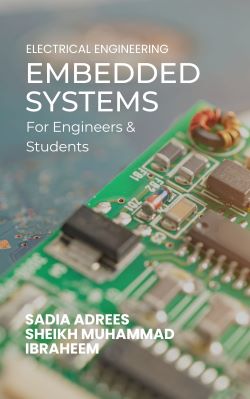Embedded Systems For Engineers and Students
Embedded Systems for Engineers and Students: written by Sheikh Muhammad Ibraheem and Sadia Adrees is a comprehensive textbook designed to provide an in-depth understanding of the principles and practical applications of embedded systems. The book begins with an introduction to the basics of embedded systems, including the hardware and software components, design methodologies, and programming languages. It then delves into the different types of microcontrollers and processors commonly used in embedded systems, their architectures, and how to program them using low-level programming languages such as C and C++.
The book also covers topics such as real-time operating systems, interrupts, and event-driven programming. It discusses the importance of software testing and debugging techniques and introduces students to different debugging tools and methods.
It is a valuable resource for anyone interested in learning about embedded systems. It provides a comprehensive introduction to the principles and practical applications of embedded systems, making it an ideal textbook for students and a useful reference guide for practicing engineers.
Key Features of the Book:
1. Learns embedded systems and programmable circuits.
2. Learn what are circuits and how easy they are to design.
3. How programming languages interacts with the circuits.
4. Modern techniques in electrical and electronics circuit designing.
Book Description:
The highly complex processing capabilities found in modern digital gadgets utilised in homes, cars, and wearables are made up of embedded systems. This book will demonstrate how to create circuits using various circuit components and how to create programmable circuits with various microcontrollers. The book takes you through the fundamental concepts of embedded systems, including real-time operation and the Internet of Things (IoT). In order to create a high-performance embedded device, the book will also assist you in becoming familiar with embedded system design, circuit design, hardware fabrication, firmware development, and debugging. You’ll explore techniques such as designing electronics circuits, use of modern embedded system software, electronics circuits. By the end of the book, you’ll be able to design and build your own complex digital devices because you’ll have a firm grasp of the ideas underpinning embedded systems, electronic circuits, programmable circuits, microcontrollers, and processors.
The Learning Outcomes:
After reading this book a reader will have a depth understanding in embedded systems, microcontroller, sensors, actuators, embedded programming. Will be able to understand the modern embedded systems functionality and will be able to design such complex engineering systems. A reader will be able to do the following.
1. Understand the concepts of voltage and current in electrical circuits.
2. Understand the fundamentals of real-time embedded systems and sensors.
3. Develop robust, reliable, and efficient firmware in C++.
4. Learn to work on various state of the art processors and microcontrollers.
5. Thoroughly test and debug embedded device hardware and firmware.
6. Construct low cost and efficient programmable circuits.
